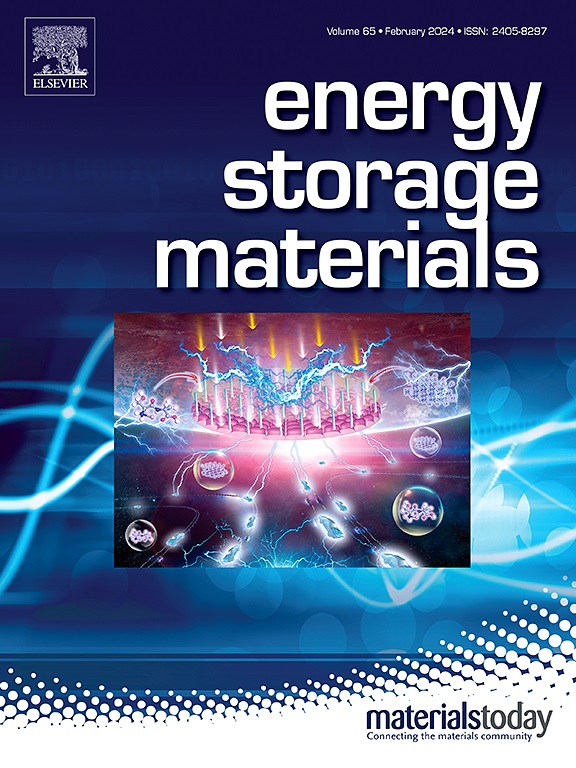An all-in-one approach for sulfide solid electrolyte with bidirectional stabilization shells enabling 4.6 V all-solid-state lithium batteries
IF 18.9
1区 材料科学
Q1 CHEMISTRY, PHYSICAL
引用次数: 0
Abstract
The narrow electrochemical window of sulfide electrolytes can lead to different failure mechanisms at the interfaces of the cathode and anode sides. The introduction of distinct modification strategies for the cathode and anode sides increases the complexity of the fabrication process for sulfide-based all-solid-state lithium batteries (ASSLBs). In this work, an integrated modification strategy was employed by introducing lithium bis(trifluoromethanesulfonyl)imide (LiTFSI) shells during the wet refinement process of Li6PS5Cl (LPSC), which successfully in situ constructed robust fluorinated interfaces on both the cathode and anode sides simultaneously. On the lithium anode side, the decreased electronic conductivity of LiTFSI@LPSC and the generation of fluorinated interface effectively suppressed lithium dendrite growth, which was further confirmed by the Density-Functional Theory (DFT) calculations. As a result, the Li|LiTFSI@LPSC|Li cell realized the critical current density up to 1.6 mA cm−2 and stable cycling performance over 1500 h at 0.2 mA cm−2. On the cathode side, the LiTFSI@LPSC not only enhanced Li+ transport within the composite cathode, but also the LiTFSI shell in situ decomposed into LiF based cathode electrolyte interphase (CEI). The capacity retention achieved 98.6 % after 500 cycles at 2C with LiNi0.83Co0.11Mn0.06O2 (NCM83) at high cut-off voltage of 4.6 V. The functionalized LiTFSI@LPSC facilitates comprehensive, all-in-one interfacial modification for both the anode and cathode sides, significantly simplifying the interface engineering in sulfide-based ASSLBs while delivering exceptional electrochemical performance.
硫化物电解质的电化学窗口较窄,会导致正负极界面出现不同的失效机制。在正负极面引入不同的改性策略会增加硫化物全固态锂电池(ASSLB)制造工艺的复杂性。在这项工作中,我们采用了一种综合改性策略,即在 Li6PS5Cl(LPSC)的湿法精炼过程中引入双(三氟甲磺酰)亚胺锂(LiTFSI)外壳,成功地在正负极侧同时原位构建了稳固的氟化界面。在锂阳极侧,LiTFSI@LPSC 电子电导率的降低和氟化界面的生成有效抑制了锂枝晶的生长,这一点在密度泛函理论(DFT)计算中得到了进一步证实。因此,锂|LiTFSI@LPSC|锂电池实现了高达 1.6 mA cm-2 的临界电流密度和在 0.2 mA cm-2 下超过 1500 h 的稳定循环性能。在阴极侧,LiTFSI@LPSC 不仅增强了 Li+ 在复合阴极内的传输,而且 LiTFSI 壳原位分解为基于 LiF 的阴极电解质相(CEI)。在 4.6 V 的高截止电压下,使用 LiNi0.83Co0.11Mn0.06O2 (NCM83),在 2C 条件下循环 500 次后,容量保持率达到 98.6%。
本文章由计算机程序翻译,如有差异,请以英文原文为准。
求助全文
约1分钟内获得全文
求助全文
来源期刊

Energy Storage Materials
Materials Science-General Materials Science
CiteScore
33.00
自引率
5.90%
发文量
652
审稿时长
27 days
期刊介绍:
Energy Storage Materials is a global interdisciplinary journal dedicated to sharing scientific and technological advancements in materials and devices for advanced energy storage and related energy conversion, such as in metal-O2 batteries. The journal features comprehensive research articles, including full papers and short communications, as well as authoritative feature articles and reviews by leading experts in the field.
Energy Storage Materials covers a wide range of topics, including the synthesis, fabrication, structure, properties, performance, and technological applications of energy storage materials. Additionally, the journal explores strategies, policies, and developments in the field of energy storage materials and devices for sustainable energy.
Published papers are selected based on their scientific and technological significance, their ability to provide valuable new knowledge, and their relevance to the international research community.
 求助内容:
求助内容: 应助结果提醒方式:
应助结果提醒方式:


